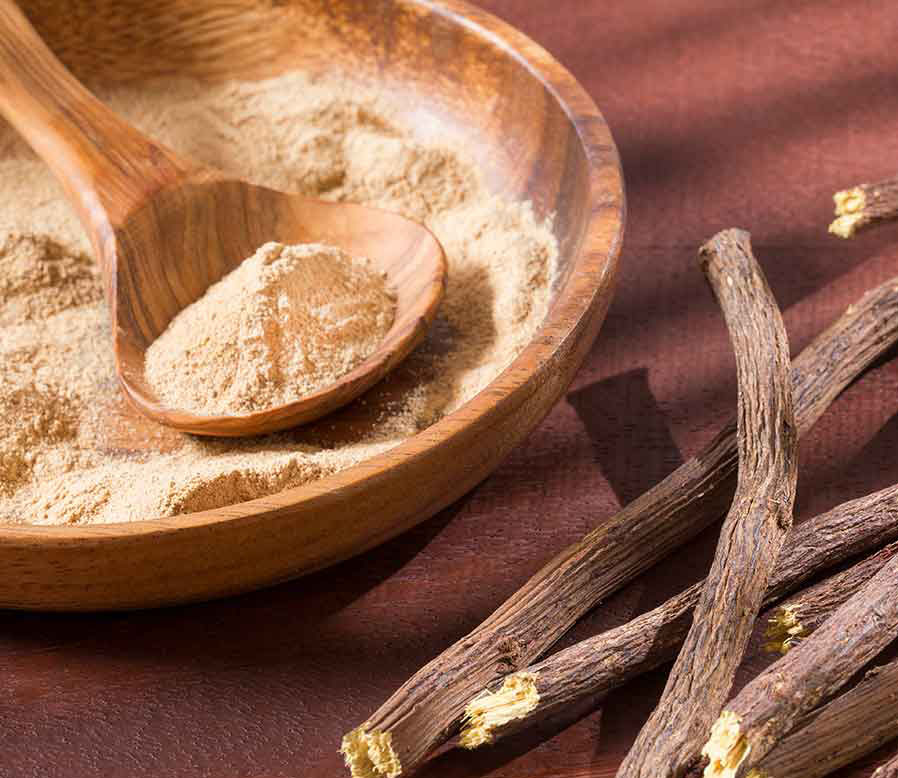Licorice roots Powder in bulk packaging shipped in 20″ FCL container
Login to view prices
Licorice root, which is considered one of the world’s oldest herbal remedies, comes from the root of the licorice plant (Glycyrrhiza glabra) . Native to Western Asia and Southern Europe, licorice has long been used to treat various ailments and flavor candies, drinks, and medicines.
Licorice root, which is considered one of the world’s oldest herbal remedies, comes from the root of the licorice plant (Glycyrrhiza glabra) .
Native to Western Asia and Southern Europe, licorice has long been used to treat various ailments and flavor candies, drinks, and medicines.
Despite this history, only some of its uses are backed by scientific research. Furthermore, licorice may carry several health risks.
How is licorice root used?
Medicinal use of licorice dates back to ancient Egypt, where the root was made into a sweet drink for pharaohs.
It has also been used in traditional Chinese, Middle Eastern, and Greek medicines to soothe an upset stomach, reduce inflammation, and treat upper respiratory problems.
Contemporary uses
Today, many people utilize licorice root to treat ailments like heartburn, acid reflux, hot flashes, coughs, and bacterial and viral infections. It’s regularly available as a capsule or liquid supplement.
Additionally, licorice tea is said to soothe sore throats, while topical gels are claimed to treat skin conditions like acne or eczema.
What’s more, licorice is used to flavor some foods and beverages
Surprisingly, many licorice candies are flavored not with licorice root but with anise oil — an essential oil from the anise plant (Pimpinella anisum) that has a similar taste.
Plant compounds
While it contains hundreds of plant compounds, licorice root’s primary active compound is glycyrrhizin.
Glycyrrhizin is responsible for the root’s sweet taste, as well as its antioxidant, anti-inflammatory, and antimicrobial properties
However, glycyrrhizin is also linked to many of the adverse effects of licorice root. As a result, some products use deglycyrrhizinated licorice (DGL), which has had the glycyrrhizin removed .
Potential benefits
Current research shows promise for several of licorice root’s medicinal uses.
May aid skin conditions
Licorice root contains over 300 compounds, some of which demonstrate potent anti-inflammatory, antibacterial, and antiviral effects In particular, animal and test-tube studies link glycyrrhizin to anti-inflammatory and antimicrobial benefits As a result, licorice root extract is used to treat a variety of skin conditions, including acne and eczema.
In a 2-week study in 60 adults, applying a topical gel containing licorice root extract significantly improved eczema.
Though topical licorice gels have also been used to treat acne, research on its effectiveness is mixed and quite limited.
May reduce acid reflux and indigestion
Licorice root extract is often used to relieve symptoms of indigestion, such as acid reflux, upset stomach, and heartburn.
In a 30-day study in 50 adults with indigestion, taking a 75-mg licorice capsule twice daily resulted in significant improvements in symptoms, compared with a placebo .
Licorice root extract may also alleviate symptoms of gastroesophageal reflux disease (GERD), including acid reflux and heartburn.
In an 8-week study in 58 adults with GERD, a low dose of glycyrrhetinic acid in combination with standard treatment resulted in significant improvements in symptoms.
Another study in 58 adults with GERD noted that the daily use of licorice root was more effective at reducing symptoms over a 2-year period than commonly used antacids.
While these results are promising, larger human studies are necessary.
May help treat peptic ulcers
Peptic ulcers are painful sores that develop in your stomach, lower esophagus, or small intestine. They’re commonly caused by inflammation resulting from H. pylori bacteria .
Licorice root extract and its glycyrrhizin may help treat peptic ulcers.
One study in mice found that licorice extract doses of 91 mg per pound (200 mg per kg) of body weight protected against these ulcers better than omeprazole, a common peptic ulcer medication.
While more research is needed in humans, a 2-week study in 120 adults showed that consuming licorice extract in addition to a standard treatment significantly reduced the presence of H. pylori .
May have anticancer properties
Due to its content of numerous plant compounds with antioxidant and anti-inflammatory effects, licorice root extract has been studied for its protective effects against certain types of cancer .
In particular, licorice extract and its compounds have been linked to slowing or preventing cell growth in skin, breast, colorectal, and prostate cancers.
As research is limited to test tubes and animals, its effects on human cancers are unknown.
Yet, licorice root extract may help treat oral mucositis — very painful mouth sores that people with cancer sometimes experience as a side effect of chemotherapy and radiation
A 2-week study in 60 adults with head and neck cancer revealed that a topical licorice film was just as effective as the standard treatment for oral mucositis.
May ease upper respiratory conditions
Due to their anti-inflammatory and antimicrobial effects, both licorice root extract and tea may aid upper respiratory conditions.
In particular, animal studies conclude that glycyrrhizin extract from licorice root helps relieve asthma, especially when added to modern asthma treatments .
While limited human research shows similar results, more rigorous, long-term studies are needed.
Additionally, limited test-tube and human studies suggest that licorice root tea and extract may protect against strep throat and prevent sore throat after surgery.
Still, further research is needed.
May protect against cavities
Licorice root may help protect against bacteria that can lead to cavities.
A 3-week study gave 66 preschool-aged kids sugar-free lollipops containing 15 mg of licorice root twice per day during the school week. Consuming the lollipops significantly reduced the number of Streptococcus mutans bacteria, which are the main cause of cavities.
Test-tube studies also show licorice root extract to be effective at protecting against bacteria commonly linked to cavities and tooth decay
However, more research is needed on the optimal dose and form of licorice root.
Other potential benefits
Licorice root extract is tied to several other potential benefits. It may:
- Aid diabetes. In a 60-day study in rats, daily intake of licorice root extract resulted in significant improvements in blood sugar levels and kidney health. This effect has not been confirmed in humans.
- Reduce menopause symptoms. Licorice root extract has been proposed as a treatment for hot flashes during menopause. However, the evidence on its effectiveness for this purpose is limited.
- Boost weight loss. Some studies indicate that licorice root extract lowers body mass index (BMI) and supports weight loss. Yet, other studies have not found any effects on weight .
- Help treat hepatitis C. One test-tube study noted that adding glycyrrhizin to a standard hepatitis C treatment significantly reduced the virus’s spread. While promising, these results have not been confirmed in humans .
Export Markets:
We export our products to many countries all over the world. USA, France, Germany, China, Malaysia, Algeria, Morocco, Indonesia…etc
Quotation:
- Incoterms: FOB
- Quantity: one 20″ FCL Container Minimum
- Specification: 100% natural and Pure quality
- Documentation: COA, MSDS, TDS, GC Peaks
- Packaging: Bulk Packaging
- Payment terms: TT in advance to Our bank account
- Lead time: Shipping through 10 days from receipt of the payment.
- Sea Shipping Time: 35 days
- Air shipping time: 10 days
Quality Certificates:
- ISO 9001-2015
- ISO 22000-2005
- GMP accredited by AQC Middle East FZE
- KOSHER Certificate
- Halal Certificate
- ORGANIC Certificate accredited by CERES GmbH Germany
- NOP Certificate accredited by CERES GmbH Germany
- Egyptian Ministry of Health Permission
Contact us please to receive other supporting documents for our Oils :
- COA
- MSDS
- TDS
Branding Services
We also can do customized packaging for you to pack whatever size you like. We can help in designing labels, selecting good packets or bags. We deliver integrated solutions under your brand..
Organically Certified product Available upon request
Additional information
| Weight | 12000 kg |
|---|---|
| Dimensions | 610 × 244 × 259 cm |
| Country of Origin | India |
| Ship from | India |
| 20 Container Capacity H | 12000 kg |
| Herbal Part Types | Roots, Powder |
| Herbs Packaging | PE bags 25 Kg, PE Bags 50 kg, Paper Bag 25 kg, Paper Bag 50 kg |
| Cultivation Type | Organic, Conventional |
| HS Code | 09109990 |
| Custom Branding & Packaging | Yes, OEM Custom banding, designing and packaging are available for that product |
| Herbal OEM Packaging | Kraft Bag, Kraft Bag with transparent window, Kraft bag with open side, Glass Jar, Glass jar Spices with holed lid, Tea bag, Tea bag with paper bag, Tea Cylinder packaging, Tin Packaging |
| Documentation & Certifications | Allergen Free Certificate, Bovine Spongiform Encephalophathy (BSE) Certificate, GMO Certificate, GRAS Status Statement, Herbal Origin Statement, Organic Certificate, Pesticide Residual Certificate, Halal Certificate, KOSHER Certificate, Researches & Studies, Certificate of Analysis (COA), Technical Data Sheet (TDS) |
-
Login to view prices
Calendula officinalis Marigold Flowers in Carton Shipped in 20″ FCL Container
Login to view prices Read more -
Login to view prices
Dehydrated Bell Sweet Pepper Paprika Capsicum annuum in bulk packaging
Login to view prices Read more -
Login to view prices
-
Login to view prices
Anise Pimpinella anisum Seeds in Bulk packaging Shipped in 20″ FCL Container
Login to view prices Read more -
Login to view prices
-
Login to view prices












